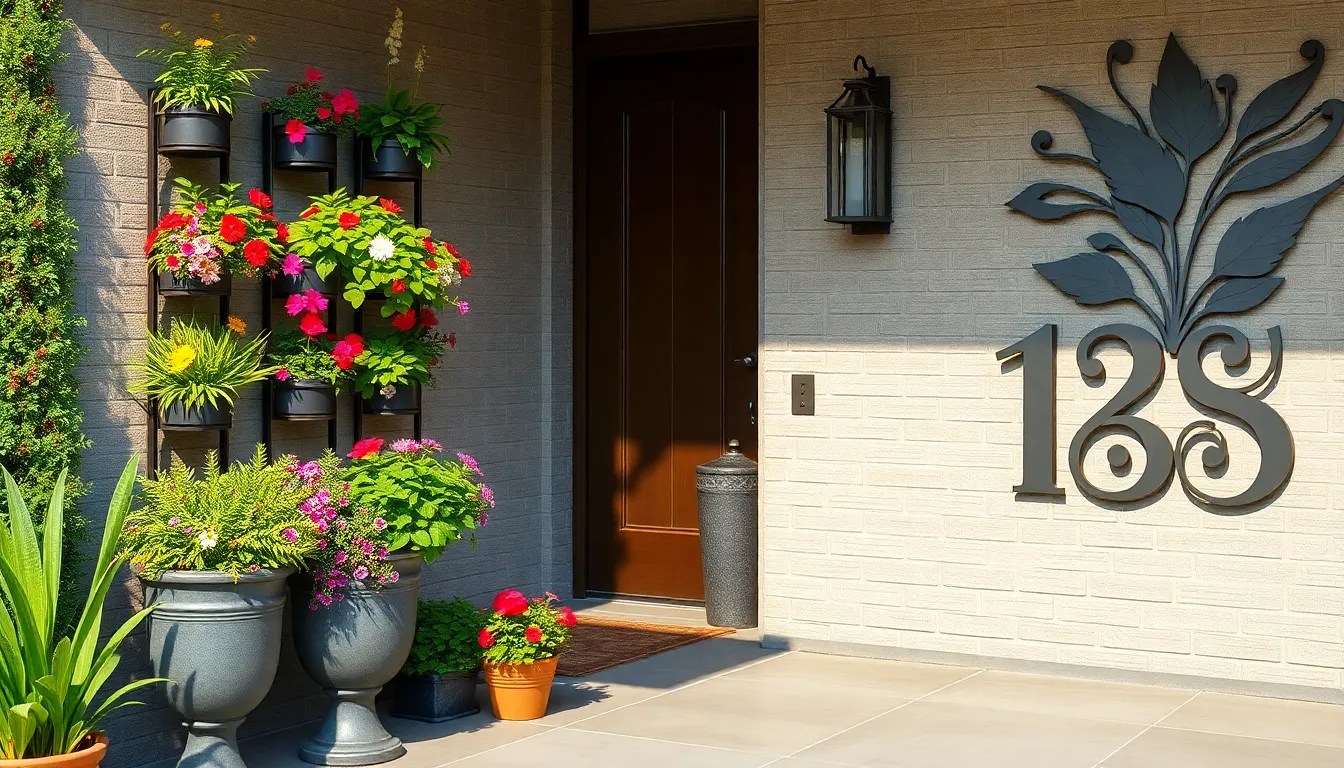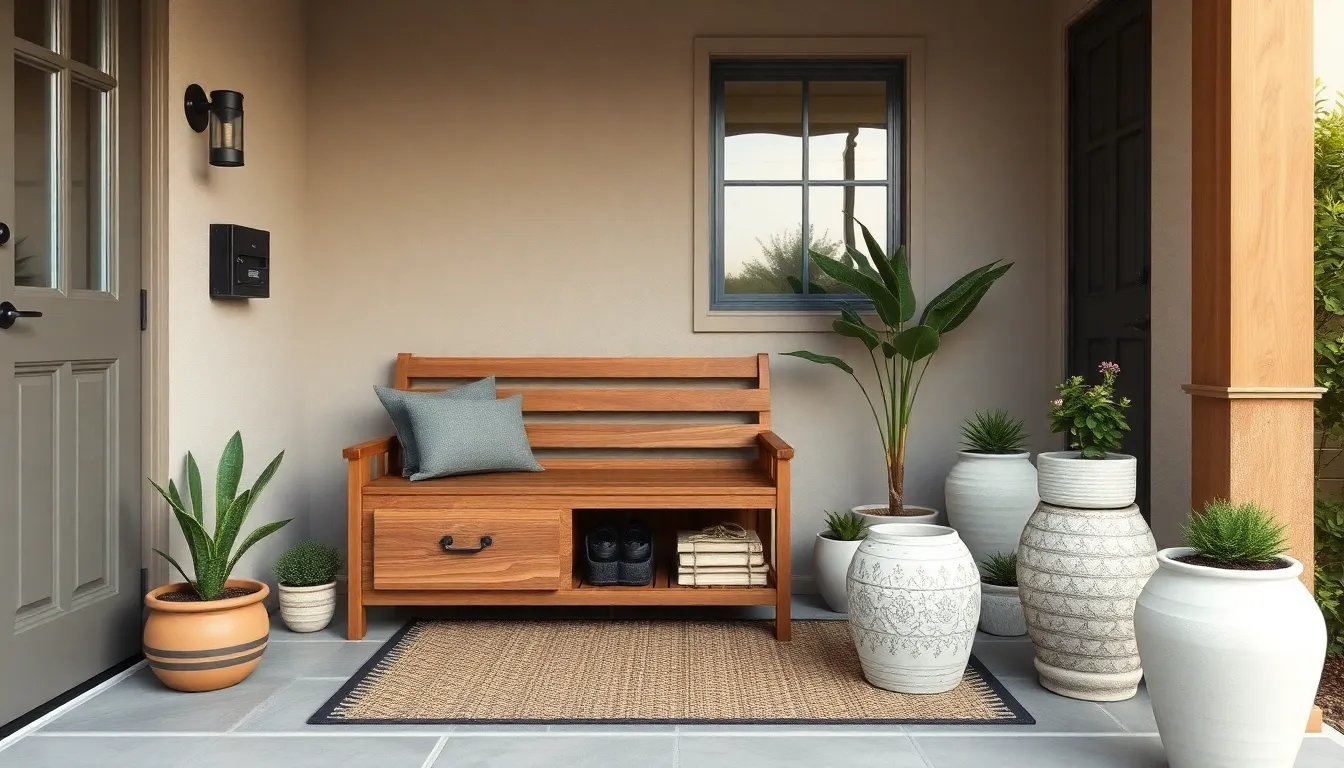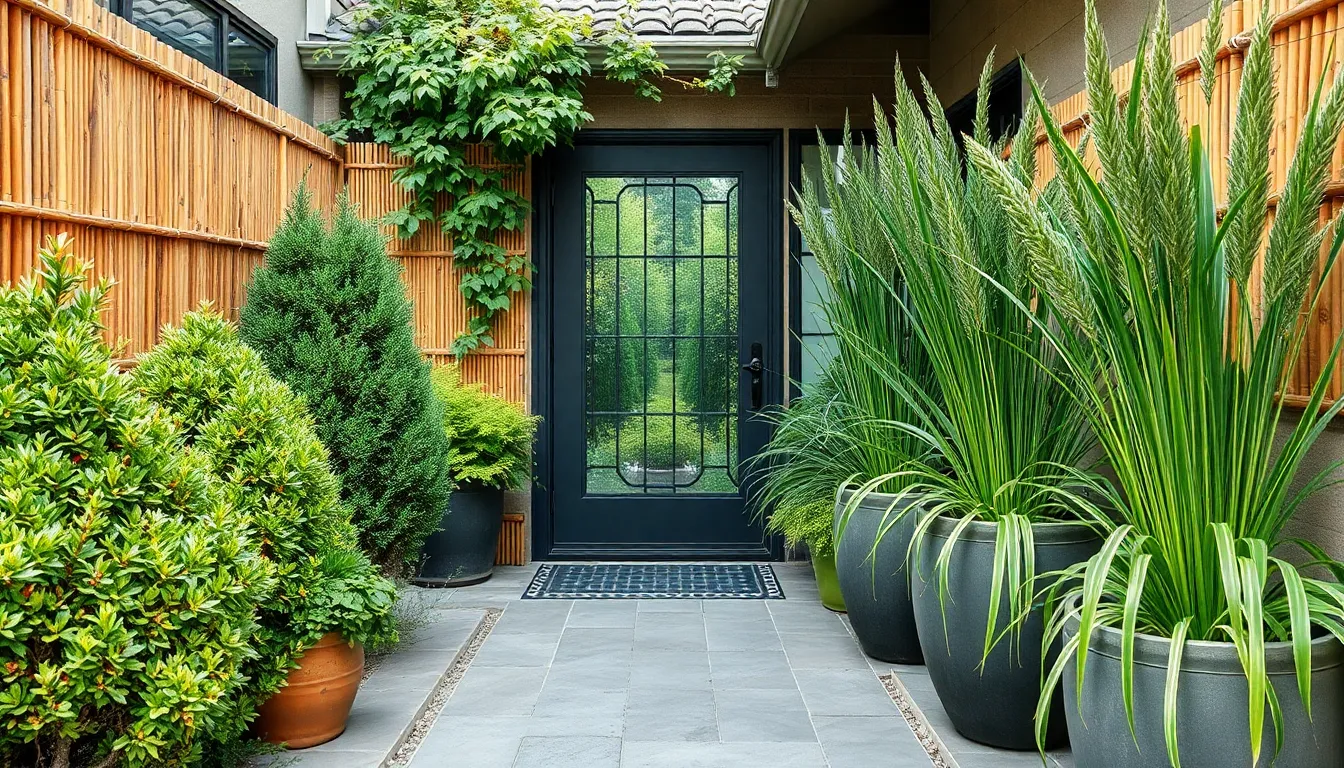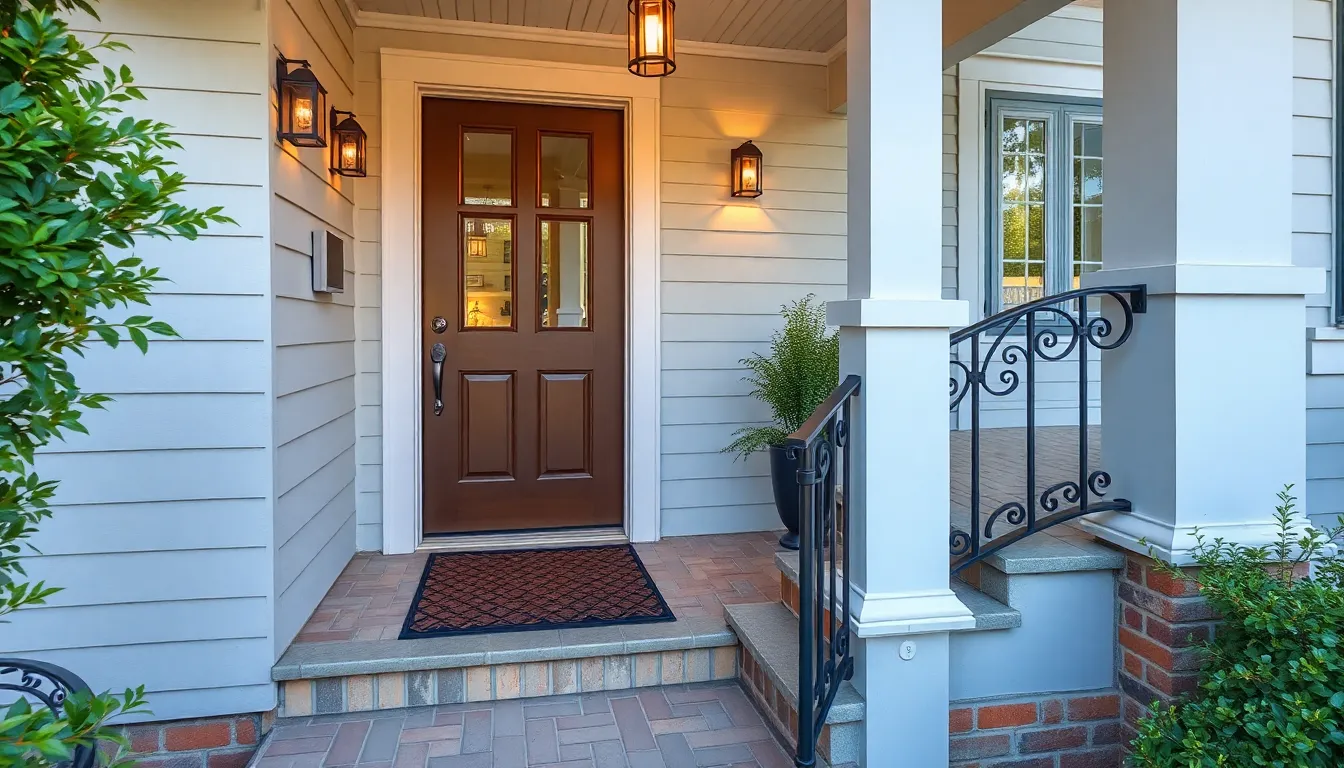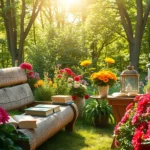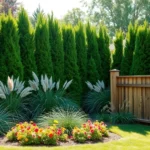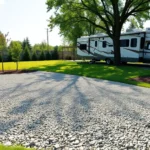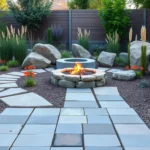We all know that first impressions matter – and your home’s entryway is often the very first thing guests notice. But what happens when you’re working with a small outdoor space that feels cramped or uninspiring? Don’t let limited square footage discourage you from creating a welcoming entrance that reflects your style.
Small outdoor entryways present unique opportunities to maximize impact through smart design choices. Whether you’re dealing with a narrow front porch, a tiny apartment balcony, or a compact doorway area, we’ve discovered countless ways to transform these spaces into stunning focal points that guests will remember.
From clever storage answers to eye-catching décor that doesn’t overwhelm your space, we’ll show you how to make every inch count. These practical ideas prove that size doesn’t determine style – sometimes the most charming entryways come in the smallest packages.
Create a Welcoming First Impression With Colorful Container Gardens
Container gardens transform cramped entryways into vibrant outdoor spaces that greet visitors with natural beauty. We’ll show you how strategic planting choices can maximize your small space’s visual impact.
Choose Weather-Resistant Planters in Various Heights
Durable materials like fiberglass, concrete, and powder-coated metal withstand harsh weather conditions while maintaining their appearance season after season. These materials resist cracking, fading, and corrosion better than traditional clay or plastic options.
Creating visual layers with planters of different heights adds depth to your small entryway design. Mix tall urns measuring 24-30 inches with medium containers at 12-18 inches and low bowls at 6-10 inches for ever-changing arrangements.
Position the tallest containers at corners or against walls to anchor your display without blocking foot traffic. Medium height planters work well flanking doorways, while shorter containers can line pathways or steps.
Lightweight options like resin or aluminum planters make seasonal rearranging easier in compact spaces. These materials allow you to experiment with different layouts without straining your back or damaging surfaces.
Select Low-Maintenance Plants for Year-Round Appeal
Evergreen shrubs like boxwood, dwarf conifers, and holly provide consistent structure throughout all seasons. These plants require minimal pruning and maintain their shape with little intervention.
Ornamental grasses such as fountain grass, blue fescue, and Japanese forest grass add texture and movement to container displays. They’re drought tolerant once established and need cutting back only once per year.
Succulent varieties including hens and chicks, sedum, and jade plants thrive in containers with minimal watering requirements. These plants store water in their leaves, making them perfect for busy homeowners or frequent travelers.
Native perennials adapted to your climate zone reduce maintenance while supporting local wildlife. Research plants native to your area through your local extension office or native plant society.
Incorporate Seasonal Flowers for Continuous Color
Spring bulbs like tulips, daffodils, and crocuses provide early season color when planted in fall. Layer different varieties with staggered bloom times to extend the flowering period from March through May.
Summer annuals including petunias, marigolds, and impatiens deliver vibrant color from late spring through first frost. Replace spent blooms weekly to encourage continuous flowering and maintain neat appearances.
Fall mums, pansies, and ornamental cabbage extend color into cooler months while complementing autumn decorations. These plants tolerate light frosts and often bloom until hard freezes arrive.
Winter interest plants like evergreen boughs, red twig dogwood, and winterberry maintain visual appeal during dormant months. Add these elements to existing containers or create dedicated winter displays using seasonal branches and berries.
Maximize Vertical Space With Wall-Mounted Storage Solutions
When floor space is at a premium in small outdoor entryways, we turn our attention upward to unlock hidden storage potential. Wall mounted answers keep essential items organized while maintaining the open feel that makes compact spaces appear larger.
Install Floating Shelves for Decorative Items
Floating shelves transform blank wall space into stylish display areas for plants, lanterns, and seasonal decor. We recommend installing shelves at varying heights to create visual layers that draw the eye upward and make the ceiling appear higher. Strategic placement of decorative items like potted herbs, small outdoor lanterns, or weather resistant candles adds personality without consuming valuable floor space.
These shelves work particularly well for showcasing rotating seasonal displays that keep your entryway fresh throughout the year. Consider installing two to three shelves at different levels to create depth and visual interest while providing ample storage for your favorite outdoor decorative pieces.
Add Hooks for Keys, Bags, and Outdoor Gear
Hooks mounted directly onto exterior walls provide instant access to daily essentials like keys, bags, hats, and jackets. We suggest installing hooks at different heights to accommodate various family members and gear types. Heavy duty outdoor hooks can support everything from lightweight tote bags to bulky winter coats.
Multiple hook arrangements work best when positioned near the door for maximum convenience. Weather resistant materials like stainless steel or powder coated metal ensure your hooks withstand outdoor elements while maintaining their functionality and appearance over time.
Use Wall Pockets for Mail and Small Essentials
Wall pockets offer discrete storage answers for mail, sunglasses, gloves, and other small items you grab when heading out. These organizers attach easily to exterior walls and keep frequently used items within arm’s reach of your door. Weather resistant fabric or metal wall pockets prevent moisture damage while maintaining easy access to essentials.
Positioning wall pockets at eye level ensures quick visibility of contents and reduces the likelihood of forgotten items. We find that wall pockets work exceptionally well for storing gardening gloves, plant care tools, or even spare house keys in waterproof containers.
Define Your Space With Strategic Lighting Options
Strategic lighting transforms even the smallest outdoor entryway into a clearly defined and inviting entrance zone. Well-placed fixtures create visual boundaries while ensuring your space feels welcoming and secure after dark.
Install Solar-Powered Path Lights for Safety
Solar-powered path lights offer the perfect solution for illuminating walkways without complicated wiring installations. We recommend placing these energy-efficient fixtures every 3-4 feet along your pathway to create consistent lighting that guides visitors safely to your door. These lights automatically charge during daylight hours and provide reliable illumination throughout the evening, making them ideal for small outdoor setups where power access might be limited.
Most solar path lights feature weather-resistant construction and can withstand seasonal changes without maintenance concerns. Low-profile designs won’t overwhelm your compact entryway while still delivering the safety benefits you need. Consider models with warm LED bulbs that create a welcoming glow rather than harsh white light that can feel institutional.
Add String Lights for Ambient Evening Atmosphere
String lights instantly add warmth and charm to small porches and entryways without consuming precious floor space. We suggest draping them along railings, around doorframes, or overhead between posts to create a cozy evening atmosphere that makes guests feel welcome. Battery-operated versions eliminate the need for outdoor outlets, giving you more flexibility in placement options.
Edison bulb string lights provide vintage appeal while LED versions offer energy efficiency and longer lifespan. Choose warm white or soft yellow tones that complement your home’s exterior colors. For year-round use, select weatherproof options rated for outdoor conditions that can handle rain, snow, and temperature fluctuations.
Consider Motion-Sensor Fixtures for Security
Motion-sensor lighting adds an essential security layer by illuminating your entryway only when movement is detected near your door. We recommend positioning these fixtures to cover key approach angles without creating harsh shadows that might obscure visibility. Strategic placement ensures the light activates when someone approaches while conserving energy during inactive periods.
LED motion sensors offer the best combination of brightness and efficiency, with many models providing adjustable sensitivity settings and timer controls. Wall-mounted versions work well for small spaces since they don’t require floor space or complex installation. Look for fixtures with wide detection ranges that can sense movement from various angles, deterring unwanted visitors while welcoming expected guests.
Transform Bare Walls With Eye-Catching Outdoor Art
Bare walls at your entryway offer untapped potential for creating stunning visual impact without consuming precious floor space. We’ve discovered that strategically placed outdoor art can transform even the most basic entrance into a memorable first impression.
Hang Weather-Resistant Wall Sculptures
Metal wall sculptures designed specifically for outdoor use deliver maximum visual impact in minimal space. These durable pieces withstand rain, snow, and harsh UV rays while maintaining their aesthetic appeal year after year. We recommend selecting sculptures with natural motifs like leaves, birds, or abstract designs that complement your landscaping.
Positioning these sculptures at eye level creates an immediate focal point that draws visitors toward your entrance. Consider grouping smaller pieces together for dramatic effect, or choose one statement piece that commands attention. The key is selecting finishes like powder-coated metal or treated steel that resist rust and fading.
Create a Living Wall With Vertical Planters
Vertical planting systems maximize greenery without sacrificing walkway space in compact entryways. We’ve found that wall-mounted planters filled with succulents, herbs, or seasonal flowers create stunning living artwork that changes throughout the year.
Installing modular planting systems allows you to customize your display based on seasonal preferences and plant care requirements. Drought-tolerant plants like sedums and echeveria thrive in vertical arrangements with minimal maintenance. For shadier entryways, ferns and hostas provide lush texture and year-round interest.
Consider incorporating a drip irrigation system for larger installations to ensure consistent watering without daily maintenance. This approach keeps your living wall vibrant while reducing the time commitment required for upkeep.
Display House Numbers in Stylish Typography
House numbers serve as both functional necessities and design opportunities that shouldn’t be overlooked. We recommend selecting oversized, weatherproof numerals in materials like brushed metal, carved wood, or illuminated acrylic that complement your home’s architectural style.
Bold typography transforms standard address markers into artistic statements that enhance curb appeal. Mounting numbers on contrasting backgrounds creates visual separation that improves visibility from the street. For modern homes, sleek sans-serif fonts work beautifully, while traditional properties benefit from classic serif or script styles.
Backlighting your house numbers with LED strips ensures visibility during evening hours while adding sophisticated ambiance to your entryway. This combination of form and function creates a polished look that welcomes guests while serving practical purposes.
Add Functional Seating for Small Entryway Comfort
Beyond improving visual appeal, small outdoor entryways need functional elements that make daily routines more convenient. Adding seating transforms these compact spaces into practical areas where we can comfortably put on shoes, set down packages, or simply pause before entering our homes.
Choose Compact Benches With Hidden Storage
Compact benches with built-in storage solve two challenges at once in small entryways. These dual-purpose pieces provide comfortable seating while creating hidden compartments for shoes, gloves, and other outdoor essentials. Storage benches maximize space efficiency by eliminating the need for separate furniture pieces, keeping our entryways organized and clutter-free.
Weather-resistant materials like teak or powder-coated metal ensure these benches withstand outdoor conditions year-round. We recommend measuring your entryway carefully to select a bench that fits proportionally without overwhelming the space. Built-in compartments work particularly well for seasonal items that we don’t need daily access to but want kept nearby.
Install Wall-Mounted Fold-Down Seats
Wall-mounted fold-down seats offer seating answers for extremely tight spaces where floor furniture isn’t practical. These innovative seats fold down when we need them and tuck completely away when not in use, preserving precious square footage in narrow entryways. Installation requires only wall space, making them perfect for porches or entryways with limited floor area.
Sturdy mounting hardware ensures these seats support adult weight safely when deployed. We suggest positioning fold-down seats at standard chair height, approximately 18 inches from the ground, for comfortable use. Some models include small shelves or hooks that remain accessible even when the seat is folded up.
Use Decorative Stools That Double as Plant Stands
Decorative stools bring versatility to small entryway seating arrangements through their multiple functions. These pieces serve as occasional seating when we need to sit briefly, then transform into plant stands to display potted flowers or greenery. Lightweight materials like ceramic or resin allow us to move stools easily between different uses.
Weatherproof finishes ensure decorative stools maintain their appearance through seasonal changes. We can group multiple stools at varying heights to create visual interest while providing flexible seating options for guests. Their compact footprint makes them ideal for corners or alcoves where larger furniture wouldn’t work effectively.
Incorporate Smart Storage for Everyday Essentials
Small outdoor entryways require strategic storage answers that maximize functionality while maintaining an uncluttered appearance. We’ll explore practical storage options that keep daily essentials organized and accessible without overwhelming your limited space.
Add a Slim Console Table With Drawers
Narrow console tables with built-in drawers serve as perfect centerpieces for compact outdoor entryways. These furniture pieces provide surface space for decorative elements while concealing everyday items like mail, gloves, and keys within easy reach. Weather-resistant materials such as teak or powder-coated aluminum ensure your console table withstands outdoor conditions year-round.
Position your slim console against a wall to maximize walkway space while creating a designated drop zone for essentials. Drawers keep smaller items like sunglasses or dog leashes neatly hidden from view. Top surfaces accommodate stylish bowls for keys or seasonal decorative accents that complement your overall design scheme.
Install Overhead Shelving for Seasonal Items
Overhead shelving maximizes vertical storage without compromising precious floor space in your small entryway. Mount shelves 7-8 feet high to store seasonal items such as winter hats, gardening supplies, or holiday decorations that aren’t needed daily. Wall-mounted brackets support decorative baskets that contain loose items while maintaining visual appeal.
Strategic placement above doorways or windows utilizes often-overlooked areas for practical storage. Cedar or composite materials resist moisture and temperature fluctuations common in outdoor environments. Baskets or bins on overhead shelves keep items dust-free and organized while contributing to your entryway’s aesthetic design.
Use Decorative Baskets for Quick Organization
Decorative baskets provide immediate organization answers while adding texture and visual interest to your outdoor entryway. Place woven or rattan baskets near the entrance to collect shoes, umbrellas, or pet accessories that typically create clutter. These containers make cleanup effortless while maintaining an organized appearance for unexpected guests.
Different basket sizes accommodate various storage needs throughout your entryway space. Larger baskets handle bulky items like sports equipment or gardening tools. Smaller versions organize mail, keys, or seasonal accessories within easy reach. Natural materials like seagrass or bamboo complement outdoor environments while providing durable storage answers that enhance your entryway’s welcoming atmosphere.
Create Privacy and Style With Natural Screening
Building on our storage and seating answers, we’ll explore how natural screening transforms small entryways into private sanctuaries while maintaining their welcoming appeal. Living barriers offer the perfect balance between seclusion and style.
Plant Fast-Growing Shrubs Along Boundaries
Fast-growing shrubs create natural privacy walls that enhance your entryway’s charm year-round. Privet hedges reach 3-4 feet in height within two growing seasons, forming dense screens that block unwanted views from neighboring properties. Boxwood varieties like Green Velvet maintain compact growth while providing evergreen coverage that looks polished in formal settings. Laurel shrubs offer broader leaves and faster establishment, with some varieties adding 2-3 feet of growth annually.
We recommend spacing these shrubs 18-24 inches apart for quick coverage without overcrowding. English laurel works exceptionally well for shaded entryways, while Japanese privet thrives in sunny locations with minimal water requirements. These living boundaries add substantial curb appeal while defining your entryway’s boundaries naturally.
Install Bamboo or Reed Fencing Panels
Bamboo panels bring instant privacy with tropical sophistication to compact outdoor spaces. These lightweight screens install easily against existing walls or as freestanding dividers, requiring only basic mounting hardware for secure attachment. Reed fencing offers similar benefits with a more rustic aesthetic that complements cottage-style homes and natural landscaping.
Standard 6-foot panels provide adequate screening for most entryways while allowing gentle airflow and filtered light penetration. Rolled bamboo fencing costs approximately $30-50 per 50-foot section, making it an affordable privacy solution for budget-conscious homeowners. We suggest selecting panels with galvanized wire backing for enhanced durability against wind and weather exposure.
These eco-friendly materials require minimal maintenance beyond occasional cleaning with mild soap and water to preserve their natural appearance.
Use Tall Grasses in Large Containers
Ornamental grasses in substantial planters create flexible screening that moves with your design needs. Pampas grass reaches 6-8 feet in height within one growing season, forming dramatic plumes that sway gracefully in breezes while blocking sightlines. Fountain grass varieties like Purple Fountain or Hameln offer more compact options at 3-4 feet tall, perfect for smaller entryways requiring subtle screening.
Large ceramic or fiberglass containers measuring 20-24 inches in diameter provide adequate root space for healthy grass development. Maiden grass varieties such as Morning Light create elegant vertical screens with variegated foliage that adds texture and visual interest throughout growing seasons.
Container placement allows seasonal rearrangement to accommodate changing privacy needs or design preferences. We recommend using wheeled plant caddies for containers over 50 pounds to enable easy repositioning without strain.
Enhance Safety and Accessibility With Practical Features
We can’t overlook the importance of making our small outdoor entryways safe and accessible for everyone who visits our home. Safety features don’t have to compromise style when we choose the right answers for our compact spaces.
Install Non-Slip Mats for Wet Weather
Non-slip mats provide essential traction during rainy or wet conditions when surfaces become dangerously slippery. We should place these safety mats directly in front of our door and at the bottom of any steps to prevent falls. Rubber mats with raised patterns work best for outdoor use since they channel water away while maintaining grip. Weather-resistant materials ensure our mats won’t deteriorate quickly from constant exposure to moisture and UV rays.
Choosing mats that complement our entryway’s color scheme helps them blend seamlessly with our overall design. We can find options in neutral tones like charcoal or brown that hide dirt while providing maximum safety benefits. For small spaces, we recommend selecting mats sized proportionally to avoid overwhelming the area while still covering high-traffic zones effectively.
Add Handrails for Steps and Uneven Surfaces
Handrails offer crucial support for elderly visitors and anyone with mobility challenges handling our entryway. We should install sturdy railings alongside any steps, even single-step entries, to provide stability and confidence. Metal railings work exceptionally well for outdoor installations since they resist weather damage and require minimal maintenance over time.
Positioning handrails at the standard height of 34 to 38 inches ensures they’re comfortable for most people to grasp. We can choose decorative options that enhance our entryway’s aesthetic while serving their practical purpose. Wrought iron railings add classic elegance, while modern steel designs complement contemporary home styles perfectly.
For uneven surfaces or slight grade changes, we should consider installing railings along the entire walkway approach. This extra support helps prevent stumbles on irregular pavement or natural stone pathways that create small height variations.
Ensure Adequate Lighting for Evening Entry
Proper lighting transforms our entryway into a secure and welcoming space after dark while highlighting potential hazards. We need to illuminate steps, walkways, and door areas to prevent accidents and deter unwanted visitors. Motion sensor lights provide excellent security benefits by activating only when someone approaches our entrance.
Wall sconces flanking our door create symmetrical lighting that enhances both safety and curb appeal. We should position these fixtures at eye level to avoid casting harsh shadows while providing adequate illumination for key insertion and package handling. LED bulbs offer energy efficiency and long-lasting performance for our outdoor lighting needs.
Pendant lights work beautifully over covered entryways, adding ambient lighting that makes guests feel welcomed. We can install dimmer switches to adjust brightness levels based on the time of evening and our exact needs. Solar powered options eliminate wiring concerns while providing reliable illumination throughout the night in most climates.
Conclusion
We’ve shown you that small outdoor entryways don’t have to compromise on style or functionality. With the right combination of vertical storage smart lighting and creative design elements you can transform even the tiniest space into a welcoming entrance that reflects your personal taste.
The key lies in maximizing every square inch through strategic planning and multi-functional answers. From container gardens that add natural beauty to fold-down seating that saves space these ideas prove that limitations often spark the most innovative designs.
Your entryway sets the tone for your entire home so don’t let size constraints hold you back. Start with one or two elements that speak to you and gradually build your perfect outdoor welcome space.
Frequently Asked Questions
How can I make my small outdoor entryway more inviting?
Focus on strategic lighting, colorful container gardens, and eye-catching elements like weather-resistant wall art. Use vertical space with wall-mounted storage and add compact seating with hidden storage. Layer plants at different heights and incorporate seasonal flowers for year-round appeal. These elements work together to create a welcoming atmosphere despite limited space.
What are the best plants for small entryway container gardens?
Choose low-maintenance options like evergreen shrubs and ornamental grasses for year-round structure. Add seasonal flowers for continuous color throughout the year. Use weather-resistant planters in various heights to create visual layers and depth. Lightweight containers allow for easy rearrangement when needed.
How do I maximize storage in a tiny outdoor entrance?
Install floating shelves at varying heights for decorative items, add hooks near the door for keys and bags, and use wall pockets for mail storage. Consider a slim console table with drawers as a centerpiece, overhead shelving for seasonal items, and decorative baskets for quick organization while maintaining visual appeal.
What lighting works best for small outdoor entryways?
Solar-powered path lights placed every 3-4 feet provide safe walkway illumination. String lights create warmth and charm without using floor space. Motion-sensor fixtures offer security while conserving energy. Wall sconces and pendant lights enhance evening safety while creating a welcoming atmosphere for visitors.
How can I add privacy to my small entryway?
Use fast-growing shrubs like privet and boxwood for natural privacy walls. Install bamboo or reed fencing panels for instant, stylish screening. Place tall ornamental grasses in large containers for flexible privacy that can be rearranged as needed. These natural elements provide seclusion while enhancing aesthetic appeal.
What safety features should I include in my small outdoor entrance?
Install non-slip mats for wet weather traction and handrails for steps or uneven surfaces. Ensure adequate lighting with motion sensors, wall sconces, or pendant lights for evening safety. Choose weather-resistant materials and position lighting to prevent accidents while maintaining the entryway’s welcoming atmosphere.
How do I choose the right house numbers for my small entryway?
Select oversized, weatherproof numerals that enhance curb appeal and visibility. Consider various materials and styles that complement your home’s architecture. Add backlighting options for nighttime visibility and ambiance. Position numbers at eye level where they’re easily visible from the street while serving as a design element.
What seating options work in very small outdoor spaces?
Choose compact benches with hidden storage for dual functionality. Use weather-resistant materials like teak or powder-coated metal for durability. In extremely tight spaces, install wall-mounted fold-down seats that tuck away when not needed. Decorative stools can double as plant stands, offering versatility and visual interest.




